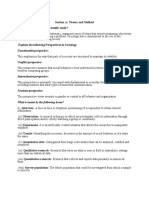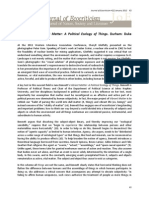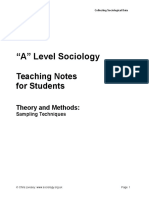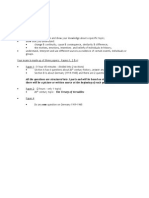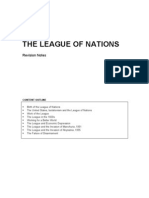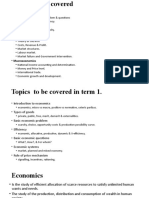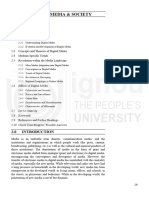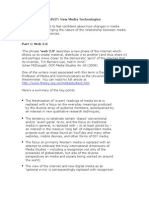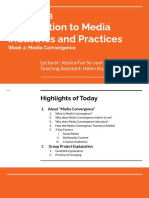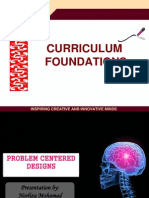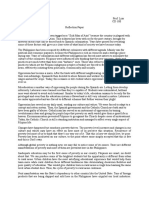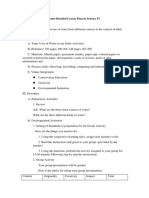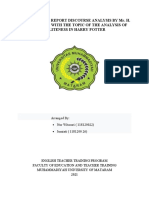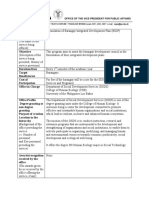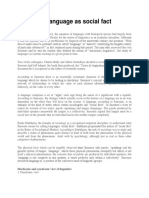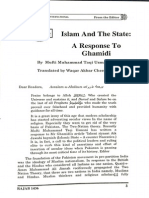Professional Documents
Culture Documents
A Level Sociology Media Revision Notes
A Level Sociology Media Revision Notes
Uploaded by
Can't Relate BOriginal Description:
Copyright
Available Formats
Share this document
Did you find this document useful?
Is this content inappropriate?
Report this DocumentCopyright:
Available Formats
A Level Sociology Media Revision Notes
A Level Sociology Media Revision Notes
Uploaded by
Can't Relate BCopyright:
Available Formats
lOMoARcPSD|28098618
For more revision resources, including
access to live online A-level sociology
tuition and revision please visit
ReviseSociology.com
A Level Sociology
Media
Revision Notes
Written for the AQA Sociology Specification
Exam paper 7192 (2): Topics in Sociology
Part of the ‘Media’ Revision Bundle’ 1 © Karl Thompson 2019
Downloaded by Danish Syafiq ([email protected])
lOMoARcPSD|28098618
A Level Sociology of The Media – AQA Specification
The AQA says that students are expected to be familiar with sociological explanations of the
following content:
• the new media and their significance for an understanding of the role of the media in
contemporary society
• the relationship between ownership and control of the media
• the media, globalisation and popular culture
• the processes of selection and presentation of the content of the news
• media representations of age, social class, ethnicity, gender, sexuality and disability
• the relationship between the media, their content and presentation, and audiences.
Sociology of Media: Revision Notes Specific Contents
The specific sections of this revision hand-out are derived from the above guidelines.
The New Media and their significance for an understanding of the role of the media in
contemporary society
1. Characteristics of New Media
2. Who is using New Media?
3. The neophiliac perspective on new media
4. The cultural pessimist perspective on new media
The relationship between ownership and control of the media
5. Defining and measuring concentration of media ownership
6. The Pluralist theory of the media
7. The instrumentalist Marxist theory of the media
8. The neo Marxist theory of the media
The media, globalisation and popular culture
9. The postmodern perspective on globalisation and popular culture
10. The cultural imperialist perspective on globalisation and popular culture
Downloaded by Danish Syafiq ([email protected])
lOMoARcPSD|28098618
The selection and presentation of the content of the news
11. News as a ‘window on the world’ vs the social construction of the News
12. Organisational routines and the news
13. The Marxist perspective on the news
14. Moral Panics
Media representations of age, social class, ethnicity, gender, sexuality and disability
15. Representations of social class
16. Representations of gender
17. Representations of sexuality
18. Representations of ethnicity
19. Representations of age
20. Representations of Disability
The relationship between the media, their content and presentation, and audiences
21. The hypodermic syringe model
22. The two-step flow model
23. The reception analysis model
24. The selective filter model
25. The cultural effects model
26. The postmodernist model of audience effects
Downloaded by Danish Syafiq ([email protected])
lOMoARcPSD|28098618
1. The Main Characteristics of New Media
New media is a broad term referring to communications technologies such as the internet and social
media which are digital and more interactive than traditional forms of media.
New media is digital
With the growth of digital technology in the 1990s, the vast majority of information is now converted,
stored and transmitted as binary code (a series of 1s and 0s.). Qualitative information has today
become ‘digitalised’.
Digitalisation is what allows so much information to be stored in compact hard disks or micro memory
cards and it is also what allows for the near instantaneous transmission of information via cable and
satellite.
Digitalisation has also resulted in ‘technological convergence’, or the convergence of different forms
of information (text, audio and visual) into one single ‘system’ - most web sites today offer a fusion
of text and audio-visual information, and our mobile devices allow us to perform a variety of functions
- not only reading text and watching/ listening to videos, but also searching for information, sending
messages, shopping and using GPS functions.
Analogue is the opposite of digital. It is stored in physical form and examples include print
newspapers, records, and old films and T.V. programmes stored on tape.
New media is characterised by interactivity
‘Old media’ tended to be very much a ‘one way’ affair, with audiences on the receiving end of
broadcasts, for the most part able to do little else that just passively watch media content.
New Media however is much more of a two way affair and it allows consumers and users to get
more involved.
Increased interactivity can be seen in simple acts such as liking a Facebook post or commenting on
news piece or blog. However, some users get much more involved and create their own blogs and
videos and actively upload their own content as ‘prosumers’.
New Media seem to have fostered a more participatory culture, with more people involved and the
roles between consumer and producer of media content becoming ever more blurred!
Downloaded by Danish Syafiq ([email protected])
lOMoARcPSD|28098618
New media is hypertextual
Hypertext, or ‘links’ are a common feature of new media, which allows users more freedom of choice
over how they navigate the different sources of information available to them.
In more technical terms, links in web sites offer non-sequential connections between all kinds of
data facilitated by the computer. Optimists tend to see this feature as allowing for more individualised
lifestyle choices, giving users the chance to act more independently, and to make the most of the
opportunities new media markets make available to them.
Global Networks
Digital Media has also facilitated cultural globalisation - we now interact much more globally and via
virtual networks of people rather than locally.
These networks allow for ‘collective intelligence’ to increase - they allow us to pool our resources
much more easily and to draw on a wider range of talents and sources of information (depending
on our needs) than ever before.
Virtual Worlds
New Media presents to us a very different reality from face to face to ‘lived reality’ - for most of us this means
a very fast paced flow of information with numerous products and people screaming for our attention.
However, this situation has only existed since the mid 2000s, and it must be remembered that New Media
reality is virtual reality. This is especially true when it comes to social media sites which give users the
opportunity to present themselves in any way they see fit, and while most users don’t go full Cat Fish, most
people choose to present only one aspect of themselves.
Simulation
Simulation goes a step beyond the ‘virtual’ nature of New Media as usual. Simulation is most obviously
experienced computer games which provide an immersive experience for users into a “virtual life” that is
simulated through digital technology.
These virtual worlds are synthetic creations that ultimately rely on algorithms which set the parameters
through which events in the gaming environment unfold.
Examples today include not only online RPG games, but also driving and flight simulations.
Source - Adapted from Martin Lister et al - New Media: A critical Introduction (Second Edition).
Downloaded by Danish Syafiq ([email protected])
lOMoARcPSD|28098618
2. Who uses new media?
What are the patterns of new-media usage in the UK by age, social class and gender? Is there still
a digital divide?
In 2019, almost nine in ten (87%) UK households had internet access, and adults who use the
internet spent, on average, 3 hours 15 minutes a day online (in September 2018) (1)
Around 70% of UK adults have a social media account and about one in every five minutes spent
online is on social media (1)
The number of households connected to the internet and the use of New Media has increased
rapidly in the last decade, but statistics from OFCOM clearly show that there are still differences in
new media usage by age, social class and gender.
The generation digital divide
New media usage varies significantly by age:
AGE 16-24s 45-54s: 55-64s: AGE 75+
• 99% use a mobile • 98% use a mobile • 96% use a mobile • 81% use a mobile
phone phone phone phone
• 79% watch on- • 69% watch on- • 43% watch on- • 22% watch on-
demand or demand or demand or demand or
streamed content streamed content streamed content streamed content
• 93% have a social • 76% have a social • 58% have a social • 20% have a social
media profile media profile media profile media profile
• 1% do not use the • 7% do not use the • 19% do not use the • 48% do not use the
internet (2) internet (2) internet (2) internet (2)
• 47% play games • 10% play online • 5% play online • 5% play games
online (4) games (4) games (4) online (4)
Downloaded by Danish Syafiq ([email protected])
lOMoARcPSD|28098618
The social class digital divide
Working-age adults in DE socio-economic group1 households are more than three times as likely
as those in non-DE households to be non-users of the internet (14% vs. 4%). (1)
The contrast is best shown by comparing the highest socio-economic group (AB) with the lowest
socio-economic group (DE)
Socio-Economic Group AB: Socioeconomic Group DE:
• 97% use a mobile phone • 93% use a mobile phone
• 73% watch on-demand or streamed content • 46% watch on-demand or streamed content
• 74% have a social media profile • 56% have a social media profile
• 57% correctly identify advertising on Google • 37% correctly identify advertising on Google
• 6% do not use the internet (2) • 23% do not use the internet (2)
The gender digital divide
• In 2017, women (81%) continue to be more likely to have a profile/ account, compared to men
(74%). (4)
• Women are more likely than men to say they have ever seen content that upset or offended them
in social media over the past year (58% vs. 51%). (4)
• (50%) of men say they are ‘very’ interested in the news (50%) compared to only a third (34%) of
women. Twice as many women (15%) as men (8%) are not interested. (4)
• A quarter of men (24%) play games online, compared to 9% of women. (4)
Sources
1. OFCOM – Online Nation 2019 -
https://www.ofcom.org.uk/__data/assets/pdf_file/0024/149253/online-nation-summary.pdf
2. OFCOM – Media Use and Attitudes Report 2019 -
https://www.ofcom.org.uk/__data/assets/pdf_file/0021/149124/adults-media-use-and-
attitudes-report.pdf
3. OFCOM’s Interactive data link.
4. https://www.ofcom.org.uk/__data/assets/pdf_file/0011/113222/Adults-Media-Use-and-
Attitudes-Report-2018.pdf
Downloaded by Danish Syafiq ([email protected])
lOMoARcPSD|28098618
3. The neophiliac perspective on new media
Neophiliacs argue that the internet and social media have been beneficial to society and individuals.
New Media have created more opportunities for individuals to find information, offered individuals
greater choice and freedom, provided new ways for people to interact with each other, resulted in
more people challenging the powerful and increased economic growth.
Easy access to more information and advice
The internet makes it very easy to access a wide variety of information about almost anything, often
for free. Some of the more obvious examples here include Wikipedia, instructional videos on
YouTube and various blogs where many experts will provide their expertise for free.
24 hour news coverage from a variety of sources and the option to switch on instant notifications
also makes it very easy to stay in touch with what’s occurring in the world.
It is also increasingly possible to ‘hack’ an education online, as many colleges and universities post
their learning materials for free (often lectures on YouTube) and there are various blogs around in
which people have put together syllabuses which link to free information.
The internet also makes it easier for people to seek confidential advice and support for sensitive
issues such as mental health issues, abuse and addiction.
Greater individual freedom and choice
Social media allow people the chance to construct new online identities and give them greater
freedom to express themselves than ever before. Online, individuals can experiment with new
identities in the comfort of anonymity and expand their personal boundaries.
Social media and blogs have proven to be an accessible way for marginalised or disadvantaged
peoples to find a voice – there are many active LGBT and disabled bloggers for example.
New social networks and global connections
The internet has blurred the boundaries between the local and the global, resulting in the emergence
of a ‘new global village’, with more daily communicative interactions occurring now than ever in
human history.
The global internet makes it easier for individuals to make new global connections that wouldn’t be
possible just at the local level or through traditional (one-way) media – as a result of social media
sites like Facebook there are now thousands of new ‘tribes’ with millions of people interacting on a
daily basis.
Downloaded by Danish Syafiq ([email protected])
lOMoARcPSD|28098618
Social media apps also make it easier for families and friends to stay in touch anywhere in the world,
and while nothing new, this opens up the possibility for people to move to other places yet still stay
connected.
Challenging power and revitalising democracy
The internet allows people to access a wide variety of political opinions and commentary and to
easily ‘fact check’ what politicians are saying, making it easier to hold those with political power to
account.
There are thousands of blogs which voice radical political opinions which challenge the dominant
mainstream neoliberal voice in the mainstream news.
The internet has also provided a platform for many social movements and allowed them to expand
the reach of their voice and activism. Extinction Rebellion is one of the best recent examples of this,
with many of their protests being organised via social media.
All of these points apply equally as well to holding corporate as well as political power to account.
The growth of E-commerce
The internet has made it very easy to buy all sorts of goods and services, and at very cheap prices
if you shop via the largest sites such as Amazon.
Comparison sites allow people to easily compare the costs of utilities and other services, and to
easily switch to the best deal, which is empowering for consumers.
Finally, the internet has also allowed thousands of people to set up or enhance their business – by
selling goods and services online.
Downloaded by Danish Syafiq ([email protected])
lOMoARcPSD|28098618
4. The cultural pessimist view of the new media
Cultural pessimists point to the possible downsides of the new media such as the rise of Fake News,
domination of a few media companies, the rise of echo-chambers, the reinforcing of elite power and
increasing commercialisation.
More information is not necessarily a good thing
There may be more information, more news channels and blogs, but a lot this is just copied and
modified slightly or recycled from other places.
Some of the information online may just be ‘fake news’ – deliberately misleading to serve political
or corporate ends. The Vote Leave campaign is a good example of this.
More information sources make it more difficult to verify the sources of information, and this is not
always possible (in which case you should not use the information!)
information overload may be a problem – having too much data too deal with.
Constant news feeds can lead to us just being ‘distracted by the new’ rather than taking the time to
look at one thing in depth. We end up with a shallower understanding of the world as a result.
Domination by media conglomerates
Pessimists argue that rather than the internet being a free space which allows for the free
development of individual expression, it has come to be controlled by a handful of big tech
companies – namely Amazon, Google, Apple and Facebook.
These companies have invested hugely in New Media in the last decade and they now control not
only access to social media sites but also search engines and the web servers which store our
information.
There are examples of people being de-platformed without warning or reason on YouTube and
Twitter – typically those who hold radical views, suggesting these companies determine who can
express what on social media.
So marginalised groups might be able to blog and have a say, but you’ll only be able to find them if
these companies allow you!
10
Downloaded by Danish Syafiq ([email protected])
lOMoARcPSD|28098618
Echo Chambers etc…
Social Media has led to more polarisation and conflict - Social networks are increasingly isolated
from each other into ‘bubbles’ or ‘echo chambers’ – people find other people with the same views
as them and they all follow each other and just reinforce their own views of the world. People are
now less likely to see views which challenge their own. As a result, we have a polarisation of opinion.
The case of Brexit is a great example of this.
As well as allowing for ordinary people to connect with each other globally, the internet also makes
it easier for organised crime networks to commit phishing (mass emails) and to sell drugs online,
among other crimes.
Groups like Fortean are also a good example of the downside of online global communities – largely
anonymous groups who organised collective trolling and hacking just for the lols.
Reinforcing Elite Power
Mainstream political parties now run sophisticated advertising campaigns using big data to
manipulate the public into voting for them: Trump’s campaign and the Brexit campaign are two
examples of this.
Larger political parties and corporations have more money to spend on advertising to keep their
biased information at the top of internet search engines such as Google.
The most radical views are censored - while individuals may be free to express any opinion online,
some of the most radical have de-platformed.
Politics is much less visible than entertainment on the internet – suggesting critical political thought
is ‘drowned out’ more than ever
Surveillance – the ex-CIA analyst claimed in 2015 that the British security services had the
technology to access the information stored on people’s smartphones.
Increasing consumption and commercialisation
The internet seems to have turned into a sphere of consumption, where most of what we see is
aimed at selling us something. It is hard to read some news sites, such as The Independent,
because of the sheer amount of space devoted to advertising.
Companies such as Amazon use the data we collect to find out our preferences and sell it to
advertising companies, so they can target ads at users more effectively, thus manipulating them to
buy products they wouldn’t normally buy – it’s estimated that 1/3rd of all Amazon purchase are a
result of ‘recommendations’ for example.
11
Downloaded by Danish Syafiq ([email protected])
lOMoARcPSD|28098618
5. Defining and measuring the concentration of media ownership
Concentration of media ownership is the trend towards fewer individuals and/ or companies owning
a higher proportion of the media.
Increasing concentration of ownership has long been a concern of sociologists. For example, in
2004 Bagdikian pointed out the following trend towards increasing ownership of the media:
• In 1983, 50 corporations controlled the majority of news media in the USA
• By 1992, 22 companies owned and operated 90% of the mass media
By 2014, United States media ownership was concentrated mainly in the hands of six companies:
Comcast, Disney, 21st Century Fox/ News Corporation, Time Warner and Viacom
In the United Kingdom in 2017 10 companies received 70% of the revenue generated by all media
companies, and 40 companies received 92% of all of the revenue (source: Deloitte media metrics,
2017).
How do we measure concentration of ownership of media?
Looking at revenue share as the above examples do is only one way of measuring concentration of
ownership, however, there are several other ways concentration may be occurring which are not
measured simply by looking at how revenue is distributed….
Vertical Integration
Where one company owns all of the stages of production of media products - for example a company
owning a film production studio, and the cinema where the film is shown.
Horizontal integration
Where one company diversifies to own more types of media - e.g. when a film production company
also gets into book publishing.
Lateral expansion or diversification
When media companies branch out into non media areas - e.g. Virgin Media getting into trains and
insurance.
12
Downloaded by Danish Syafiq ([email protected])
lOMoARcPSD|28098618
Global Conglomeration
Where companies in one country buy up companies in other countries. News Corp, for example,
owns media outlets in several different countries.
Synergy
Where a media product is sold in several different forms - often as a form of marketing. For example,
a company produces a film for cinema, then a DVD, a T.V. spin off series, a sound track for
download, maybe a cartoon strip and some action figures too.
Technological convergence
Where traditional media companies link with IT companies to make sure their media products are
available across several different devices.
Final thoughts
Intuitively it seems likely that there is increasing concentration of ownership, especially with the rise
of Facebook, Google, Amazon and Apple, but at the same time it is difficult to say for certain given
the complexity of the concept of concentration of ownership
13
Downloaded by Danish Syafiq ([email protected])
lOMoARcPSD|28098618
6. The Pluralist Theory of Ownership and Control of Media
Pluralists argue that power in democratic, free market societies is spread out among diverse
competing interest groups, and not concentrated in the hands of a minority economic elite, as
Marxists suggest. According to pluralists, no one group has a monopoly on power and their view of
the media reflects their view of power in society more generally.
Media content is driven by profit
Pluralists argue that in democratic, free market economies different media companies must compete
for customers, and so they must provide the kind of content those customers want in order to make
a profit and survive. If a company fails to provide the kind of news and entertainment that people
need and want, customers will simply stop buying their media products and go elsewhere, forcing
that company out of business.
It follows that control over media content ultimately lies with consumers, not the owners of media,
because the owners need to adapt their content to fit the demands of the consumers.
Media owners primarily want to make money and so they would rather adapt their media content to
be more diverse and keep money coming in, rather than use their media channels to publish their
own narrower subjective views and opinions.
Media content thus doesn’t reflect the biased, one sided views of media owners, it reflects the
diverse opinions of the general public who ultimately pay for that media content. The public (being
diverse) generally don’t want one-sided, biased media.
Pluralists argue that media ownership has become more concentrated in recent years for economic
reasons, rather than political or ideological reasons. For example, vertical and horizontal integration
save a media company money because they no longer need to contract out to external companies.
Consumers determine content
From the pluralist perspective audiences are active rather than passive and not easily manipulated.
They are free to select, reject and re-interpret a wide range of media content, and they increasingly
take advantage of new technologies and new media to produce their own content.
It is thus ultimately the consumers of media/ the wider audience who determine media content rather
than the media owners.
14
Downloaded by Danish Syafiq ([email protected])
lOMoARcPSD|28098618
Journalists are not controlled by owners
Finally, pluralists point out that on a purely practical level media owners of large global corporations
cannot personally determine the content of all their media products, there are too many products
and too many global-level management issues to keep them occupied. Thus producers, editors and
journalists have considerable freedom to shape media content, free from the control of the big
bosses.
Criticisms of Pluralism
• Ultimately it is still owners who have the power the hire and fire journalists and they do have the
power to select high level editors who have similar views to themselves, which may subtly
influence the media agenda.
• It still requires a lot of money to establish a large media company, and ownership remains very
concentrated. There is relatively little journalism which is both independent and widely
consumed.
• Owners, editors and most journalists share an upper middle-class background and a
conservative worldview.
• The pressure to maintain profits has led to narrowing of media content – more towards uncritical,
sensationalist entertainment and less likely to be critical and independent.
15
Downloaded by Danish Syafiq ([email protected])
lOMoARcPSD|28098618
7. The Instrumentalist Marxist Theory of Ownership and Control of Media
Marxist Instrumentalist theory argues that media owners control media content, and that the media
performs ideological functions. The primary role of the media is to keep a largely passive audience
from criticizing capitalism and thus maintain the status quo.
Marxist Instrumentalist Theory is also known as the Traditional Marxist or Manipulative Approach to
the media.
Media owners control media content
Media owners are part of the ruling class elite and they consciously manipulate media content to
transmit a conservative ideology to control the wider population and maintain their wealth and
privilege.
The content of the media is thus narrow and biased and reflects the opinions of the ruling class
generally and the media owners in particular.
The government does not effectively regulate media content because the political elite are also part
of the ruling class like the media owners.
The media performs ideological functions
According to Instrumentalist Marxists, the primary role of the media is to spread ruling class ideology
and maintain the status quo, keeping the current unequal capitalist system in place.
The media performs ideological functions in many ways:
1. We see many favourable representations of (rather than critical commentary on) the wealthy -
for example Royalty, millionaires on Cribs, and middle-class lifestyles more generally in
programmes such as ‘Escape to the Country’ and ‘Antiques Road Trip’.
2. Some shows spread the 'myth of meritocracy' - Dragons Den and The Apprentice are two
wonderful contemporary examples of this.
3. The News often dismisses radical view points as extremist, dangerous or silly, and a
conservative (ruling class) view of the world as normal.
4. Negative portrayals of ethnic minorities and immigrants serve to divide the ruling class and
discourage criticism of the ruling class.
5. Entertainment distracts the public from thinking critically about important political issues.
16
Downloaded by Danish Syafiq ([email protected])
lOMoARcPSD|28098618
The audience are passive
Marxist instrumentalists see the audience as a mass of unthinking robots who are passive and easily
manipulate. They essentially take what they see in the media at face value and believe what they
see without questioning it.
Supporting evidence for Instrumentalist Marxism
• Control by owners was most obvious in the era of the Press Barons in the early part of the 20th
century, when some even said that they used their newspapers to consciously spread their
political views.
• Rupert Murdoch's control of his News Corporation since the 1970s is another good example of
an owner controlling media content. All of his newspapers have historically had a strong right-
wing point of view, which reflects his values.
• A specific example of Murdoch's control is that all of his news outlets supported the Iraq War in
2003, a war which he personally supported. It's unlikely that all the editors of all his newspapers
globally shared this view.
Criticisms of Instrumentalist Marxism
Pluralists are the biggest critics of Manipulative Marxists.
• It is impractical for media owners of large corporations to control all output on a day to day basis.
At some point they must trust editors.
• Pluralists argue that media owners are primarily motivated by making a profit and thus would
rather provide audiences with the diverse content they want rather than use their media
companies to spread their own narrow view of the world.
• The previous criticism follows on from the Pluralist view that audiences are not just passive and
unthinking, they are active and critical, and thus not easily manipulated: they can easily choose
to switch off if they don't like what they see.
• The rise of the New Media especially undermines the Manipulative approach - New Media
encourage audiences to be more active and allows for a greater range of people to produce and
share media content. It's simply not possible for owners to control such content.
17
Downloaded by Danish Syafiq ([email protected])
lOMoARcPSD|28098618
8. The Neo-Marxist Theory of the Ownership and Control of Media
Neo Marxists argue that cultural hegemony explains why we have a limited media agenda.
Journalists have more freedom than traditional Marxists suggest, and the media agenda is not
directly controlled by owners. However, journalists share the world view of the owners and use
gatekeeping and agenda setting to keep items which are harmful to elites out of the media agenda
and thus voluntarily spread the dominant ideology.
Neo-Marxists emphasise cultural hegemony
Hegemony is where the norms and values of the ruling class are taken as common sense.
According to Neo-Marxists, the reason why we have a limited media agenda is because of cultural
hegemony, not because of direct control by wealthy media owners. In other words, cultural factors
are more important than economic factors in explaining narrow media content.
Simply put, Journalists have accepted the conservative worldview of the ruling class as common
sense, and they share this world view with the ruling class – they thus unconsciously spread the
dominant ideology themselves without the need for direct control by the media owners.
Journalists voluntarily spread the dominant ideology
Journalists have the freedom to report as they please, so other factors besides economic control/
ownership determine media content, factors such as the interests of journalists and industry news
values.
HOWEVER, the broad agenda of the media is still limited because the journalists share the same
world view as the ruling class and the owners (this is known as ‘cultural hegemony’).
This is at least partly because Journalists are themselves mostly white and middle class, with more
than 50% of them having gone to private schools. They thus present a conservative/ neo-liberal
view of the world on autopilot.
Also, journalists do not want to risk their careers by annoying owners and so are reluctant to publish
content which might annoy owners.
Agenda setting and gate keeping
Agenda setting and gatekeeping are the two processes through which journalists limit media
content. They are normally used in relation to the selection and presentation of The News.
Gatekeeping = the process of choosing which items are selected for coverage, and others are kept
out.
18
Downloaded by Danish Syafiq ([email protected])
lOMoARcPSD|28098618
Agenda setting = deciding how media items are going to be framed, for example, who is going to be
invited to discuss topics and what kind of questions are going to be asked.
According to neo-Marxists gatekeeping and agenda setting tend to result in issues which are harmful
to the elite being kept out of the media, thus reinforcing the dominant ideology.
Examples of agenda-setting and gatekeeping include:
9. Only having two political parties discuss a news item – we rarely hear from the Green Party,
for example.
10. Focussing on the violence at riots and protests, rather than the issues which are being
protested about, or the cause of the riots.
11. The news taking the side of the police and the government, rather than hearing from criminals
or terrorists.
Criticisms of Neo-Marxism
• Traditional Marxists argue that it underestimates the important of economic factors, for
example the power of owners to hire and fire journalists
• As with traditional Marxism, the role of new media may make this perspective less relevant.
It is now much harder to maintain the dominant ideology, for example.
• Pluralists point out that this perspective still tends to assume the audience are passive and
easily swayed by the dominant ideology. In reality, the audience may be more active and
critical.
19
Downloaded by Danish Syafiq ([email protected])
lOMoARcPSD|28098618
9. The postmodern perspective on globalisation and popular culture
Postmodernists see the media as central to globalisation. They generally see globalisation as
inevitable and emphasise the positive effects media globalisation has had on society.
More individual choice
The globalisation of the media means that people are now more aware of hundreds of diverse
cultures all over the world, and this gives them more inspiration to break with their own local
traditions and live the lives they choose to.
There are also many more consumption opportunities: more choice of films, music, travel
opportunities and of course global products.
The boundary between high and popular culture has also blurred: some classical music artists have
sought out popular audiences for example, making high culture more accessible to the masses.
Finally, there are more opportunities for individuals to express themselves via social media.
The rejection of metanarratives
Postmodernists argue that media saturation means there are now an incredibly diverse array of
voices and opinions online.
This array challenges traditional ‘metanarratives’ – or any viewpoint which holds that there is one
truth – as is found with traditional religions, political ideologies such as Marxism and science.
As a result of media saturation, people are now more sceptical of the ‘truth claims’ of experts, which
means it is harder for those with power to manipulate people because ‘they know better’.
Participatory culture
Audiences are now more involved with the creation of media content, so the global media space is
now more participatory than old style one-way media.
Many people create and upload their own content to platforms such as YouTube, or write blogs, or
spend time maintaining their social media profiles.
Audiences also contribute by sharing and critiquing other people’s content on social media.
20
Downloaded by Danish Syafiq ([email protected])
lOMoARcPSD|28098618
The globalisation of protest
New media has been used effectively to fight oppression.
Spencer-Thomas (2008) conducted an analysis of protests against military violence in Burma – he
found that in 1998 very little media attention was received, but that by 2007, once Smart Phones
had penetrated the country, widespread global media coverage of the protests was achieved.
Some political campaigners have also used Twitter and Facebook to fight oppression – during the
Arab Spring for example. Another example is the use of Facebook by Saudi women campaigning
for the right to drive.
Cultural hybridity
Thompson (1995) argues that global media products are modified by local cultures which results in
various new hydbrid forms. Bollywood is a good example of this.
21
Downloaded by Danish Syafiq ([email protected])
lOMoARcPSD|28098618
10. The cultural imperialist perspective on globalisation and popular culture
Cultural imperialists tend to see globalisation as a one-way process, mainly involving the spread of
American power and values to other parts of the world. The cultural imperialist perspective focuses
on the negative effects which media globalisation has on local populations.
It is a Marxist theory, aligned with the neo-Marxist perspective of ownership and control and the
cultural effects theory of audience effects.
Global media keeps capitalism going
It does in three main ways:
• By generating false needs, mainly through advertising - which encourages people to see
relatively high levels of consumption as the norm.
• Through encouraging conspicuous consumption - the wide circulation of programmes about the
wealthy mean people tend to think the average level of consumption is higher than the real-world
norm.
• Through commodity fetishism - especially relevant in the age of new media: people increasingly
tend to see their smartphones as extensions of themselves, for example.
Media globalisation is Americanisation
Americanisation is a process where America imposes its cultural products on other nations and local
cultures. There are several examples of this - Hollywood movies, various sitcoms, sporting events
but also advertising.
Cultural imperialists see the effects of Americanisation as being negative. They argue it results in
the erosion of local cultures and traditions – for example when children around the world increasingly
choose American fast foods over locally produced and cooked foods.
Mcdonaldization is also part of cultural globalisation - working practices become more rationalised,
and more focussed on standardised ways of working to promote efficiency of production.
Finally, it can also be argued that Americanization has resulted in a backlash against American
culture, as with the rise of Fundamentalism.
22
Downloaded by Danish Syafiq ([email protected])
lOMoARcPSD|28098618
The political consequences of Americanisation
As with the economic and cultural aspects of globalisation, cultural imperialists also see the political
consequences of globalisation/ Americanisation in negative terms.
The spread of data surveillance threatens democracy as governments increasingly use social media
data to manipulate populations to vote as they want them to.
Finally, the sue of Smartphones has a 'dumbing down' effects, as people are constantly distracted
by waves of trivial information.
23
Downloaded by Danish Syafiq ([email protected])
lOMoARcPSD|28098618
11. News as a ‘window on the world’ vs the social construction of the News
According to all the sociologists in this section of the course, the news is a socially manufactured
product, rather than an objective 'window on the world'.
Many events happen in reality which do not get reported and those which do appear in the news are
placed in a particular order of priority and 'framed' by the questions which are asked, and by who is
asked to comment on the events.
It follows that the content and format of the news is a result of many decisions made by several
media professionals and those they work with and that the news will thus reflect the biases of those
who are involved in its creation.
'The News is Socially Constructed' = the news is a manufactured product, the result of decisions
made by media professionals about what to include and how to present what is included.
Below is a brief introduction to the factors which influence news content, including news values,
organisational routines, media owners and the background of journalists. Many of these factors are
covered in greater depth further on in this revision guide.
News Values
News Values are general guidelines which determine how newsworthy an event is. The more news
values an event has, then the more prominence the event will be given in a news programme or a
newspaper.
Examples of News Values include:
• Extraordinariness - how unusual an event is. An event which is not routine and unexpected is
more likely to be included in the news.
• Threshold - the bigger an event, the more likely it is to be included - e.g. more deaths are better.
• Negativity - generally war, violence, death, tragedy, all are more newsworthy than happy events.
• Unambiguity - the simpler, the more ‘black and white‘ an event, the more likely it is to be included
in the news agenda.
• Personalisation - if a story can be linked to an individual, and a personal story made out of it,
then it is more newsworthy.
24
Downloaded by Danish Syafiq ([email protected])
lOMoARcPSD|28098618
Organisational or Bureaucratic routines
These are logistical factors which can limit what events are included as news items and include:
• Financial costs
• Deadlines
• Time and Space
• The audience
• Journalistic ethics
Economic factors and ownership
Instrumentalist Marxists argue that owners can influence content, and a good example of this is the
control Rupert Murdoch exerted over the reporting of the Iraq war in 2003 - he was for the war and
his newspapers did not criticise it.
Advertising can also affect the news agenda – ‘independent’ news companies are dependent on
advertising revenue, so they are unlikely to report on issues which are critical of capitalism and
economic growth.
There is a hierarchy of credibility - the news generally presents the views of the elite and wealthy
first and then the radicals and critics in response, suggesting the elite view is the norm.
Most Journalists are middle class
More than 50% of journalists were educated in private schools, and most of the rest come from
middle class backgrounds.
This means they share a middle class 'establishment' view of the world and will see middle class
issues as more significant than working class interests, and/ or present the interests of the middle
classes as being the interests of everyone.
25
Downloaded by Danish Syafiq ([email protected])
lOMoARcPSD|28098618
12. Organisational Routines and News Content
Organisational routines may affect what items are selected for presentation in the news. These
include factors such as financial costs, time and space available, deadlines, immediacy and
accuracy, the audience and journalistic ethics.
Organisational routines are sometimes known as bureaucratic routines.
Financial costs
News gathering can be an expensive business, and investigative journalism and overseas reporting
are two of the most expensive types of news to produce: the former involves sustained long-term
investigation and the later involves overseas expenses.
Financial pressures have led to news companies changing the type of news they produce, with two
major consequences:
Firstly, investigative journalism has declined, and that which remains has become more about
digging up dirt on celebrities rather than in-depth exposés on corrupt politicians or corporations.
Secondly, the news has become more about infotainment – entertainment has become increasingly
important as a factor in the selection of news items. Entertaining items achieve larger audiences
which means more advertising revenue and more income.
Even the BBC isn’t immune from these pressures. OFCOM recently said of BBC News that it is
‘More Madonna than Mugabe’.
Time and space available
News has to be tailored to fit the time and space available in the newspaper or on the television
show.
For example, A typical 6 O clock BBC news show consists of around 15 items in 25 minutes, usually
with each item taking up five minutes or less, and if an item can’t be covered in this short period of
time, it is more likely that it will not be included in the news agenda.
These small time slots also limit the number of perspectives which can be given on a news item –
often restraining commentary to two people, and contributing to biased Agenda Setting (according
to Neo-Marxists).
Longer news programmes allow for more in-depth coverage of news items.
26
Downloaded by Danish Syafiq ([email protected])
lOMoARcPSD|28098618
Deadlines
This only really affects newspapers: the deadline for something to reach tomorrow’s newspaper is
around 10PM the previous evening.
Immediacy and Accuracy
An item is more likely to be included in the news if it can be accompanied by live footage and if
relevant people can be found to comment on the issue or offer soundbites.
The audience
The content of the news may change because of the perceived characteristics of the audience.
For example, The Sun is aimed at less well educated people while The Guardian is aimed at people
with a higher level of education.
The content of day time news may change to reflect the interests of stay at home parents.
Journalistic ethics
Ethics should constrain the type of news stories which are reported, and the way in which news is
reported.
All UK newspapers sign up to the Press Complaints Commission’s voluntary code of conduct which
stipulates that journalists should avoid publishing inaccurate information and misrepresenting
people and should respect people’s privacy and dignity.
However, there is some evidence that journalists do not always act ethically. For example, the News
of the World phone hacking scandal in the early 2000s – the paper hacked various celebrities and
royals’ phones as well as those of victims of the July 2005 London bombings.
The Leveson report (2012) found that news stories frequently relied on misrepresentation and
embellishment, and it seems that press watchdogs have little power to enforce journalistic ethics
today.
27
Downloaded by Danish Syafiq ([email protected])
lOMoARcPSD|28098618
13. The Marxist Perspective on the News
Marxists suggest that the news agenda is heavily interests by those with power in capitalist societies
and that the content of the news reflects the worldview and interests of the elite and middle classes.
Those working for mainstream news media may claim that the news they construct is objective and
unbiased, but this is a myth according to Marxists, and the news primarily serves to legitimate
capitalism and maintain the status quo.
Owners influence content
Owners may not be able to shape the day to day content of the news, especially live 24 hour news,
but they can shape the broader context by setting the policies of their companies and influencing
the general approach to selecting and editing news.
Owners the power to hire and fire Chief Executive Officers and other high-ranking officials, and they
can exercise direct control over such decisions because they do not have to be made that often.
According to Marxist theory, owners will generally appoint senior officials who share their ideology
and then lower ranking media professionals will avoid publishing content that might annoy them for
fear of their jobs.
The news agenda legitimates a capitalist, neoliberal view of the world
News companies rely on advertisers for their income and so it should be no surprise that the news
does not generally critique the capitalist system, in fact it does quite the opposite.
Most news programmes and papers have large sections devoted to business news and economics,
where Corporate leaders and business experts are generally deferred to and are favourably
presented.
These sections of the news rarely challenge the concept of economic growth, it is taken for granted
as a universal ‘good’, and elsewhere the news rarely focuses on issues of poverty and inequality.
The hierarchy of credibility
Journalists rank people in elite and professional positions as being more credible sources of
authority than those lower down the social class order.
Heads of companies, government officials, the police and academic experts are all more likely to be
invited to comment on news items than those from pressure groups, less popular political parties,
or just ordinary members of the general public.
The elite thus end up becoming the ‘primary definers’ of the news agenda.
28
Downloaded by Danish Syafiq ([email protected])
lOMoARcPSD|28098618
The news often reports on what such people think of events, rather than the events themselves, so
we end up with an elite/ middle class frame of the world through the news.
The class background of journalists
GUMG argue that media professionals tend to side with the elite because they share a middle-class
background with them, and thus a worldview.
News items thus tend to represent the elite and middle classes more favourably than the working
classes.
Fiske (1987) for example found that news reports on industrial disputes tended to report on
managers as ‘asking’ whereas trades unionists tended to be reported as ‘making demands’,
presenting the former as more reasonable.
29
Downloaded by Danish Syafiq ([email protected])
lOMoARcPSD|28098618
14. Moral Panics and the Media
A moral panic is an exaggerated outburst of public concern over the morality or behaviour of a group
in society.
Moral Panic Theory is strongly related to labelling theory, in fact moral panic theory is really labelling
theory applied to the media – instead of the agent of social control doing the labelling, it is the media.
Two related key terms include folk devils and deviancy amplification.
A folk devil is the subject of a moral panic – the group who the media is focussing on, the group
who is being targeted for exaggerated reporting.
Deviancy Amplification is one of the alleged consequences of a moral panic – it is where a group
becomes more deviant as a result of media exaggeration of their deviance. It is very similar to the
Self-Fulfilling Prophecy.
As with just about anything in life, all of this is much easier to understand with an example:
Stan Cohen’s (1972) study of the Mods and Rockers
Stan Cohen’s (1972) first developed the concept of the ‘moral panic’ in his study of the relationship
between the media and the Mods and Rockers in the 1960s.
The Mods and Rockers were two working class youth subcultures, the mods famously riding
scooters and dressing in smart clothes such as suits, and the rockers riding larger motorbikes and
dressing in leathers.
These were also two of the first youth subcultures in consumer society, and initially they existed
peacefully side by side – they were really just about style and music and the members of each were
primarily concerned with having a good time.
However, during one bank holiday weekend in Clacton in 1964, where both mods and rockers visited
to party, there were some minor acts of Vandalism and some violence between the two groups, this
then led to the media turning up at the next big Bank Holiday weekend in Brighton (also 1964) ‘ready’
to report on any disturbances.
Once again at Brighton there was also some minor vandalism and violence between the mods and
rockers, but this time the media were present and produced (according to Cohen) some extremely
exaggerated reports about the extent of the violence between the two groups.
This had the effect of generating concern amongst the general public and the police then responded
to this increased public fear and perceived threat to social order by policing future mods and rockers
30
Downloaded by Danish Syafiq ([email protected])
lOMoARcPSD|28098618
events more heavily and being more likely to arrest youths from either subculture for deviant
behaviour (whether violent or not).
A further consequence of the exaggerated media reporting was that the mods and rockers came to
see themselves as opposed to each other, something which hadn’t been the case before the media
exaggeration.
Some further examples of moral panics
There have been several examples of issues which might be regarded as Moral Panics:
- Inner city mugging by black youths, as outlined by Stuart Hall in Policing the Crisis
- Punks and Skinheads
- Football Hooligans
- Paedophiles
- Islamic Terrorists
- Benefit Culture
NB all of the above examples are only ‘possible’ examples of moral panics, see criticisms below.
Criticisms of moral panic theory
Cohen’s formulation of moral panic theory assumes that the audience are passive, but audiences
today are much more active and able to critically evaluate media content, which means moral panics
are less likely.
Thornton (1995) found that the media failed to generate a moral panic over rave culture, mainly
because youth culture had become mainstream by that point, as had the taking of drugs such as
ecstasy.
There are various reasons my ‘panics’ may not occur even if the media exaggerate the deviance of
some groups – the media also exaggerate the police’s ability to deal with deviance and exaggerated
reporting of deviance is so common these days that people are just desensitised to its effects.
Finally, some concerns which some may call moral panics may be legitimate – such as concerns
over child abuse or rising knife crime today.
31
Downloaded by Danish Syafiq ([email protected])
lOMoARcPSD|28098618
15. Media representations of social class
The Monarchy
According to Nairn (2002) after WWII the monarchy developed close ties with the media industry
and worked with them to reinvent itself as ‘the royal family’ and since then they have been
represented in the media as a family that are ‘like us but not like us’, and the narrative of their lives
is presented as a soap opera, and is part of our day to day media fabric, which encourages us to
identify with the royals.
Media representations of royalty also reinforce a sense of national identity: The Queen is the ultimate
figure head of the country and royal events form part of our annual calendar, as well as the fact that
royals are often in attendance at other national events, such as sporting events for example.
Media representations of wealth
The very wealthy are generally represented positively in the media, for example Alan Sugar and the
Dragons on Dragons Den.
The constant media focus on the lifestyles of wealthy celebrities tends to glamourize such lifestyles,
suggesting this is something we should all be aspiring to, rather than focussing on the injustice of
how much these people are paid compared to ordinary people.
The Middle Classes
Middle Class (higher income) families seem to be over-represented on daytime T.V. especially – in
shows such as homes under the hammer, escape to the country and antiques shows featuring
typically very high wealth/ income families, and yet presenting them as ‘the norm’.
Most T.V. presenters are middle class, and so they are more likely to identify with middle class
guests compared to working class guests, reinforcing the concerns of former as more worthy of
attention.
Most journalists and editors are privately educated which means that the news agenda is framed
from a middle-class point of views.
32
Downloaded by Danish Syafiq ([email protected])
lOMoARcPSD|28098618
The working classes
There are relatively few shows which focus on the reality of the lives of working-class people.
Mainstream soaps tend to be the most watched representations of the working classes
Jones (2011) suggests the working classes are represented as feckless racists who hate
immigration and multiculturalism – coverage of Brexit seems to offer support for this.
The underclass
Coverage tends to focus on the poverty of individuals rather than the structural features of society
such as government policy which created the underclass.
Media coverage of the underclass is generally negative, and they are often scapegoated for
societies’ problems. Benefits Street is a good example of this.
33
Downloaded by Danish Syafiq ([email protected])
lOMoARcPSD|28098618
16. Media representations of women
Women have historically been under-represented and mis-represented in stereotypical roles within
mainstream media. This section focuses on symbolic annihilation, the cult of femininity and the male
gaze as examples of this.
Under-representation and symbolic annihilation
Gaye Tuchman (1978) developed the concept of Symbolic Annihilation to refer to the under-
representation of women in a narrow range of social roles, while men were represented in a full
range of social and occupational roles.
Tuchman also argued that women’s achievements were often not reported or trivialised and often
seen as less important than things like their locks
According to Tuchman, women were often represented in roles linked to gender stereotypes,
particularly those related to housework and motherhood – a good example of this being washing
powder advertisements in which mothers and small daughters are working together, while men and
boys are the ones covered in mud.
Ferguson (1980) conducted a content analysis of women’s magazines from the end of WWII to 1980
and found that representations were organised around what she called the cult of femininity, based
on traditional, stereotypical female roles and values: caring for others, family, marriage, and concern
for appearance.
Ferguson noted that teenage magazines aimed at girls did offer a broader range of female
representations, but there was still a focus on him, home and looking good for him.
A good (historical?) example of symbolic annihilation is the representation of women’s sport. The
Women’s Sport and Fitness Foundation (2006) found that there was little coverage of women’s
sport, but what little coverage there was had a tendency to trivialise, sexualise and devalue women’s
sporting achievements.
34
Downloaded by Danish Syafiq ([email protected])
lOMoARcPSD|28098618
Misrepresentations (myths and stereotypes)
In ‘The Mouse that Roared’ Henry Giroux argued that women were represented in a narrow,
restricted and distorted range of roles.
Supporting evidence for Giroux lies in the historical representation of female characters in Disney
Films – where the typical female character is a sexualised yet delicate princess who needs to be
rescued by a stronger male character.
Examples of where Disney reinforces female stereotypes include:
• Snow White – who cleans the house of the male Dwarves and is eventually rescued by a
male prince because she is pretty.
• Beauty and the Beast – In which Belle endures an abusive and violent beast in order to
redeem him.
• Ariel – who gives up her voice to win the prince with her body.
• Mulan – who wins the war almost single handed only to return home to be romanced
Laura Mulvey ‘The Male Gaze’
Laura Mulvey studied cinema films and developed the concept of the Male Gaze to describe how
the camera lens eyed up the female characters for the sexual viewing pleasure of men.
The Male Gaze occurs when the camera focusses on women’s bodies, especially breasts, bums
and things, and spends too long lingering on these areas when it isn’t necessary.
The male gaze of the camera puts the audience in the perspective of the heterosexual men – woman
are displayed as a sexual object for both the characters in the film and the spectator – thus the man
emerges as the dominant force and the woman is passive under the active (sexual) gaze of the
man.
The overall effect of this is that women become objectified as sex objects, rather than being
represented as whole people.
Mulvey argued that the Male Gaze occurred in film because heterosexual men were in control of
the camera.
35
Downloaded by Danish Syafiq ([email protected])
lOMoARcPSD|28098618
Changes to the representations of women?
The roles of women in society have changed considerably since these historical analyses of
women’s representations: since the 1970s women now occupy a much wider range of roles and
equality with men.
David Gauntlett in ‘Media Gender and Identity’ argues that there has been an increase in the
diversity of representations and roles of women in the media since the 1970s, and a corresponding
decrease in stereotypical representations, which broadly reflects wider social changes.
The representation of women in films
There have been several films in recent decades with ‘strong’ lead female characters who are fierce,
tough and resourceful, and thus arguably subvert hegemonic concepts of masculinity.
Arguably a watershed moment in this was the 1979 film ‘Alien’ in which the female lead character
Ripley outlives her male colleagues and ultimately kills the Alien threat.
Since then a number of female heroines have featured as the lead characters in various action
movies such Terminator 2, the Tomb Raider films, Kill Bill, and The Hunger Games.
However, rather than subverting hegemonic concepts of masculinity, it could be argued that such
films still perpetuate the ‘beauty myth’ as all the above lead female characters are slim and attractive.
The Bechdel Test
The Bechdel Test is a simple test which presents a quantitative analysis of the representation of
women in relation to men in film. To pass the test a film has to pass three tests…
1. It has to have at least two (named) women in it
2. Who talk to each other
3. Above something other than a man
The website above allows you to search for films which passed the test by year, and there is clear
evidence that female characters are more visible and independent year on year, but there are still
many films which do not pass this simple basic test.
36
Downloaded by Danish Syafiq ([email protected])
lOMoARcPSD|28098618
The representation of women in Game of Thrones
At first glance, there seem to be a number of positive female characters in Game of Thrones – the
assassin and ultimate killer of the Ice King Arya Stark being the most stand-out example, with other
positive female characters including Daenerys Targaryen, Cersei Lannister, Brienne of Tarth, Sansa
Stark (once she gets through her abusive relationship).
However, various feminist commentators have argued that all of these positive representations are
let down by the end of series eight with Brienne falling apart emotionally because of her love for
Jamie Lannister, Daenerys literally going mad, Sansa apparently being strong because of her
previous abusive relationship (rather than in spite of it), and with all the anonymous women cowering
in the crypt during the battle with the Ice King, while all the anonymous men are outside fighting.
A further Feminist argument is that all of these women are portrayed as strong individuals who are
strong because they adopt male characteristics, and ultimately it is male violence which wins the
day rather than more diverse forms of feminine power.
The Cosmo effect
McRobbie argued that since the 1980s the magazine Cosmopolitan has featured positive
representations of young women as seeking to control their own lives rather than being dependent
on men.
McRobbie argues that Cosmopolitan thus challenges the cult of traditional notions of femininity as
women are no longer portrayed as the weaker sex.
The representations of women in the news
In 2015 the Global Media Monitoring group conducted quantitative content analysis of 1960 sources
covering 431 announcers and reporters.
They found that:
• The overall presence of women as sources was 28%.
• Compared to 2010 data, the number of women sources as a proportion of all sources, had
decreased by 3 per cent.
37
Downloaded by Danish Syafiq ([email protected])
lOMoARcPSD|28098618
• Women continued to remain largely confined to the sphere of the private, emotional and
subjective, while men still dominate the sphere of the public, rational and objective.
• Women were significantly under-represented in hard news stories and in all the authoritative,
professional and elite source occupational categories and are, instead, significantly over-
represented as voices of the general, public (homemaker, parent, student, child) and in the
occupational groups most associated with ‘women’s work’, such as health and social and
childcare worker, office or service industry worker.
Looking at the function women performed in stories, their contribution as experts (20%) and
spokespeople (25%) were low, instead, they were mostly called upon to voice popular opinion (54%)
or speak from their personal experience including as eye-witnesses or speak from their own subject
position.
The persistence of the Beauty Myth?
Tebbel (2000) argues that women are under more pressure than ever before to conform to the
Beauty Myth. She argues that the body and faces of real women have been symbolically annihilated,
replaced by computer manipulated, airbrushed, artificially images.
Killborn argues that media representations present women as ‘mannequins’ – size zero, tall and
thin, and with perfect blemish-free skin.
Orbach further argues that the media continues to associate slimness with health, happiness,
success and popularity
The representations of women in advertising
Some recent evidence seems to challenge the persistence of the Beauty Myth….
There seems to have been progress in this area in recent years. In 2015, Protein World launched
its ‘Beach Body Ready’ advertising campaign, and while this clearly reinforced the Beauty Myth
stereotype, it prompted a significant backlash with several of the advertisements being vandalised,
and many women posting images of their ordinary bodies on social media as a criticism of the overt
body shaming involved with Protein World’s advert.
38
Downloaded by Danish Syafiq ([email protected])
lOMoARcPSD|28098618
Since 2015, there has been an increase in the diversity of representations of women in advertising,
for example:
- Dove‘s Real Beauty‘ campaign72 featured a diverse range of body shapes and ethnicities.
- Sport England has been running its successful ‗This Girl Can‘ campaign since 2015.
In 2017, The Advertising Standards Authority launched new guidelines on avoiding gender
stereotyping in advertising and in 2019 banned two ads from airing in the UK because they
reinforced gender stereotypes.
Finally, UN women has recently launched its ‘Unstereotype Alliance‘, which challenges gender
stereotypes in advertising on a global scale. Supporters of this initiative include advertising industry
companies such as Unilever, P&G, WPP, Diageo, Google and Facebook.
-
39
Downloaded by Danish Syafiq ([email protected])
lOMoARcPSD|28098618
16, part 2: Media representations of men
Children now conducted research in the late 1990s and found that there were six common types of
representation of men in the media
• The joker – uses laughter to avoid displaying seriousness or emotinn
• The jock – demonstrates his power and strength to win the approval of other men and women
• The strong silent type (James Bond) – being in charge, acting decisively, controlling emotion and
succeeding with women.
• The big shot – power comes from professional status
• The action hero – strong and shows extreme aggression and violence
• The Buffoon – a bungling father figure, well intentioned and light hearted. (Homer). Hopeless at
domestic affairs.
(Boys to Men: Media Messages About Masculinity, Children Now 1999).
The Crisis of Masculinity, the New Man and changing representations of masculinity
As with women, the changing roles of men in society are reflected in changing representations of
men in the media. Representations of men are moving away from absolute toughness, stubborn
self-reliance and emotional silence with more male characters being comfortable with showing
emotions and seeking advice about how to deal with the problems of masculinity.
New Male Identities
• The Emo Boy – who is more caring, sharing, emotional and generally more in touch with his
feminine side
• The metrosexual male – who takes pride in appearance and has high levels of consumption.
The male beauty myth and the female gaze?
There are also an increasing amount of images within advertising which encourage men to be
concerned with body image and appearance as well as a sexualisation of male bodies, in which they
are presented as sex objects for female viewing pleasure, much in the same way as female bodies
have been traditionally been used by the media.
40
Downloaded by Danish Syafiq ([email protected])
lOMoARcPSD|28098618
17. Media representations of sexuality
Media representations of sexuality have historically been mostly heterosexual, with LGBT
representations being largely invisible.
Batchelor et al found that when gay representations did appear in the mainstream media, they
weren’t generally ‘integrated’ into plot lines, but rather gayness was part of the plot, seen as a source
of anxiety, or as a target of teasing or bullying.
Dyer (2002) observed that ‘the person’s person’ alone does not show that a person is gay, and that
the media have constructed stereotypical signs of ‘gayness’ which include certain facial expressions,
vocal tones, stances or clothing.
Craig (1992) identified three media signifiers of gayness
1. Camp – the ‘flamboyant figure of fun’ – a ‘non threatening’ representation of gayness, lying
somewhere between male and female and one of the most widely found representations
2. Macho – An openly sexual look which exaggerates aspects of traditional masculinity, as
exemplified by the village people.
3. Deviant – where gay people are portrayed as evil or devious, possibly as sexual predators or
who feel guilty about their sexuality. Such representations seem to construct homosexuality as
morally wrong.
Research conducted by Stonewall (2011) concluded that the LGBT community were being
subjected to symbolic annihilation. They found that LGBTs were disproportionately consigned to the
status of comedic relief – their characters presented as something to laugh at or deride. This was
especially found to be the case with representations of lesbianism, frequently presented as over-
sexualised and exotic, for male’s viewing pleasure.
Out of a total of 126 hours of television programmes analysed:
• 5 hours and 43 minutes focused on LGBT related issues or characters
• 46 minutes portrayed them realistically or positively.
Stoenewall noted that the majority of the coverage represented gays in particular as:
• Unhappy and distressed about their sexual orientation
• As people who had been bullied and rejected by their families
41
Downloaded by Danish Syafiq ([email protected])
lOMoARcPSD|28098618
Changing representations of LGBTs in the Media
There are several examples of contemporary shows which have LGBT characters , and in which
sexuality is largely incidental to the plots in the show, and only part of the character’s identity, rather
than them being subsumed by it, as was so often the case in early representations.
Probably the most obvious example of this on British Television is Doctor Who – which has featured
several gay characters in recent series.
In the USA (not UK unfortunately) GLAAD conducts an annual content analysis of the representation
of LGBT characters. Their 2019 report summarizes content analysis of 111 primetime shows with
857 series regular characters broadcast on the main USA networks (ABC, CBS, The CW, FOX, and
NBC).
They found that 8.8 percent of ‘series regular characters’ were LGBT, an increase of 2.4 percentage
points from the previous year’s 6.4 percent. This is the highest percentage GLAAD has found since
it first gathered data in the 2005-06 season.
Of the 8.8% of LGBT characters:
• 42% were gay men (a total of 47 characters)
• 25% were lesbian
• 29% were Bi+ characters make up 29 percent
• 4% were transgender characters
• The report also noted that last year, out bisexual actor Alan Cumming was the first gay lead in a
U.S. scripted broadcast drama on CBS’ new series ‘Instinct’.
However, closer analysis may reveal that although representation of LGBT characters is more
common than ever, these representations may not be that positive compared to straight characters.
Stefania Sarrubba argues that all of the LGBT characters in Game of Thrones are killed off before
the end of the series, except for Yara Greyjoy, who does something powerful at the end of season
eight (takes back the Iron Islands), but we don’t actually see this: the show ends focusing on all the
straight characters.
42
Downloaded by Danish Syafiq ([email protected])
lOMoARcPSD|28098618
The LGBT community and new media
The representations of LGBTs on new media are generally more positive than in mainstream media,
possibly because the content is user generated.
Social media sites have been used to generate support for same sex marriages and companies
such as Facebook and Twitter seem to be broadly supportive of the LGBT community.
Facebook highlighted its support for the LGBT community with its Celebrate Pride Rainbow Filter in
2015 and there were 3.6 million tweets in 2015 that used the #lovewins relating to the Supreme
Court’s decision to legalise same sex marriage.
However, research by the University of Alberta tracked all public tweets in the period 2012-15 that
used four negative terms about the LGBT community and recorded 56.5 million homophobic
comments.
In 2018 Stonewall recently launched its BAME LGBT Voices documentary series to give more a
voice/ presence to the diverse range of ethnicities and sexualities which are often under-represented
in mainstream media, one such example:
43
Downloaded by Danish Syafiq ([email protected])
lOMoARcPSD|28098618
18. Media representations of ethnicity
Van Dijk (1991) conducted content analysis of tens of thousands of news items across the world
over several decades and found that representations of black people could be categorised into three
stereotypically negative types of news:
• Ethnic minorities as criminals
• Ethnic minorities as a threat
• Ethnic minorities as unimportant.
Minority groups as criminals
Wayne et al (2007) found that nearly 50% of news stories concerning young black people dealth
with them committing crime.
Cushion et al analysed Sunday newspapers, nightly television news and radio news over a 16 week
period in 2008-9 and found that black young men and boys were regularly associated with negative
news values – nearly 70% of stories were related to crime, especially violent gang crime.
They further pointed out that black crime is often represented as senseless or as motivated by gang
rivalries, which little discussion of the broader social and economic context.
Back (2002) conducted discourse analysis of inner-city race disturbances and argued that the media
tends to label them as riots, which implies they are irrational and conjures up images of rampaging
mobs, which in turn justifies a harsh clampdown by the police.
There is little consideration given to the view that such disturbances may be the result of legitimate
concerns, such as responses to police and societal racism, which need to be taken seriously.
Minority groups as a threat
In recent years media moral panics have been constructed around:
• Immigrants, who are a threat in terms of their numbers and impact on jobs and welfare services.
• Refugees and Asylum seekers – analysis from the ICAR in 2005 noted that asylum seekers were often
portrayed as being a threat to British social cohesion and national identity, with such people often blamed
for social unrest.
• Muslims – who are often portrayed as the ‘enemy within’
44
Downloaded by Danish Syafiq ([email protected])
lOMoARcPSD|28098618
Moor et al found that between 2000 and 2008 over a third of stories focused on terrorism, and a
third focused on the differences between Muslim communities and British society, while stories of
Muslims as victims of crime were rare.
They concluded there were four negative media messages about Muslims:
• Islam as dangerous and irrational
• Multiculturalism as allowing Muslims to spread their message
• Clash of civilisations, with Islam being presented as intolerant, oppressive and misogynistic.
• Islam as a threat to the British way of life, with Sharia law.
Amelie et al (2007) focused on coverage of veiling as an Islamic practice, and found that media
coverage tended to present this is a patriarchal oppressive practice, with little coverage focussing
on the wearing of the veil as a choice.
Minority Groups as Unimportant
Van Dijk (1999) further noted that some sections of the media imply that white lives are more
important than non-white lives.
He claimed, for example, that black victims of crime are not paid as much attention to as whilte
victims of crime.
Shah (2008) claims that that the BBC engage in ‘tokenism’ – Black and Asian actors are cast as
presenters or in roles just to give the appearance of ethnic equality, regardless of whether they ‘fit’
into the role.
The result is that many ethnic minorities do not identify with ethnic minority characters,
As a whole the mainstream media pays little attention to the genuine concerns and interests of
ethnic minorities, because the mainstream media is dominated by a metropolitan, libera, while, male,
public school and Oxbridge educated, middle class elite,
45
Downloaded by Danish Syafiq ([email protected])
lOMoARcPSD|28098618
19. Media representations of age
This section on some of the ways in which the mainstream media represent young people and the
elderly.
Media representations of children
Children are often represented as vulnerable and as needing adult protection, which ties in with the
way in which childhood is socially constructed in contemporary society.
The advertising industry represents children as consumers, possibly deliberately to socialise them
into becoming consumers in later life, and to increase peer-pressure demand for their products.
Youth and Children’s Work has suggested that there are five major types of youth stereotype:
• Irritating/ annoying
• Binge drinking/ drug addicted
• The drain on society
• The entrepreneurial go-getter
• The exceptional super achiever.
Young people are largely represented in terms of lifestyle and identity, with much of the music and
fashion industries aiming their products at young people.
Young people (teenagers especially) are also disproportionately likely to be represented as a
problem – with a considerable amount of news coverage being devoted to youth gangs, crime and
antisocial behaviour, rather than the challenges facing teenagers or the positive things young people
do.
However, some documentaries do portray the complex issues young people face today, such as the
recent spate of school documentaries such as ‘Educating Essex’ etc.
46
Downloaded by Danish Syafiq ([email protected])
lOMoARcPSD|28098618
Media representations of old age
Age Concern (2000) identified three key media stereotypes of the elderly. Old people were
disproportionately represented as:
- A burden
- Mentally challenged
- Grumpy
Lee et al (2007) conducted a study of adverts and found that old people were underrepresented,
appearing in only 15% of ads, but of those 15%, more than 90% of representations were positive –
portraying elderly people as ‘golden agers’ enjoying healthy, active lifestyles.
There are also significant gender differences in the way old people are represented in the media:
older men are much more visible in the media than older women, and older men are much more
likely to be associated with high status and work while older women are generally associated with
the family and poverty.
47
Downloaded by Danish Syafiq ([email protected])
lOMoARcPSD|28098618
20. Media representations of disability
Barnes (1992) identified a number of recurring stereotypes of disable people including:
• Pitiable and pathetic – a staple of television documentaries, which often focus on disabled
children and the possibilities of miracle cures
• Sinister and evil – for example Villains in James Bond movies often have physical impairments
• Atmospheric or Curio – where disabled people are included in drama to enhance atmosphere of
menace, unease, mystery or deprivation.
• Super-cripples – the disabled are sometimes portrayed as having special powers, for example
blind people might be viewed as visionaries with sixth sense.
• Sexually abnormal – the media usually treat the disable as having no sense of sexuality, but
when they do there are represented as sexually degenerate.
• Incapable of participating fully in community life – disable people are rarely show as integral and
productive members of working society – Barns calls this the stereotype of omission.
Roper (2003) suggests that telethons such as Children in Need rely heavily on cute children who
are not representative of the wider disabled community. Telethons put the audience in the position
of givers and reinforce the idea that the disable receivers should be dependent on their able bodied
donors. Because telethons are primarily about raising money rather than raising awareness of the
reality of being disabled, they may end up reinforcing stereotypes of disabled people.
Newspaper representations of the disabled
Williams-Findlay (2009) examined the content of The Times and The Guardian to see whether the
coverage of the disabled had changed between 1989 and 2009.
Williams-Findlay found that the use of stereotypical words had declined in those 20 years, but that
stereotypical representations were still present in 2009 because journalists still assumed that
disability was ‘tragic’.
Watson et al (2011) compared tabloid media coverage of disability in five newspapers in 2004-5
with coverage in 2010-11 they found that:
• There had been a significant increase in the reporting of disability
• The proportion of articles reporting disability in sympathetic and deserving terms had fallen.
• In 2010-11 the reporting of groups with mental disabilities was particularly negative, often
associated with them being welfare scroungers.
• Articles focussing on disability benefit fraud increased threefold between 2005 and 2011.
48
Downloaded by Danish Syafiq ([email protected])
lOMoARcPSD|28098618
21. The hypodermic syringe model of audience effects
The hypodermic syringe model believes that the media can have a direct and immediate effect on
the audience. This model sees the audience as a ‘homogeneous mass’ (all the same), as passive
and believing what they see in the media without questioning the content.
It is thus possible for content creators to use their media productions to manipulate vulnerable
audiences into thinking or acting in certain ways.
The culture industry
This theory of media effects is associated with neo-Marxists Theodor Adorno and Max Horkheimer
in the 1940s, who had managed to escape Nazi Germany and resettled in America.
They noted that there were similarities between the ‘propaganda industry’ in Nazi Germany’ and
what they called the ‘Culture Industry’ in the United States.
Adorno and Max Horkheimer theorised that popular culture in the USA was like a factory producing
standardized content which was used to manipulate a passive mass audience.
They argued that consumption of the ‘dumbed down’ content of popular culture made people
passive and false psychological needs that could only be met and satisfied by the products of
capitalism.
The ultimate function of the culture industry was thus to manipulate audiences into becoming good
consumers and keeping capitalism going.
Further evidence that the media can have direct effects on a passive audience
One of the earliest examples is the audience response to Orson Welles’ radio adaptation of ‘War of
the Worlds‘ in 1938.
War of the Worlds is a fictional story about Alien invaders coming from Mars and killing very large
numbers of people in the process. The original radio adaptation was done in the style of a news
report, and some of the listeners who tuned in after the show had begun (and so missed the
introduction to it) actually believed they were hearing a news report, packed their cars and fled to
the country.
49
Downloaded by Danish Syafiq ([email protected])
lOMoARcPSD|28098618
Feminist sociologists such as Susi Orbach and Naomi Wolfe have highlighted how the ‘beauty myth’,
especially the representations of size zero as normal, have encouraged an increase in eating
disorders, especially among young women, as well as an increase in mental health problems.
More recent evidence suggests that the campaigns behind both Trump and Brexit used
sophisticated targeted advertising to nudge voters into voting for Trump and Brexit, suggesting the
media can have a very direct and immediate effect on specific populations (even if such campaigns
didn’t treat the audience as a ‘mass’ and so this is only partial support the Hypodermic Syringe
Model).
Imitation or Copycat Violence
One of the most researched areas of media effects is that surrounding the relationship between
media violence and real-life violence. There is some evidence that media violence can ‘cause’
people to be more violence in real-life…
The Bandura ‘Bobo Doll’ experiment is evidence that media-violence can ‘cause’ children to act
more aggressively when given the opportunity to do so. Bandura showed three groups of children
real, film and cartoon examples of a bobo-doll being beaten with a mallet. A further group of children
were shown no violence. The children were then taken to a room with lots of toys, but then ‘frustrated’
by being told the toys were not for them. They were then taken to a room with a mallet and a bobo-
doll, and the children who had seen the violent examples (whether real, film, or cartoon) imitated
the violence by beating the doll themselves, while the children who had seen no violence did not
beat the doll.
Desensitization
Newson (1994) theorised that the effects of media violence on children were more subtle and
gradual. She argued that continued exposure to violence in films over several years ‘desenstised’
children and teenagers to violence and that they came to see violence as a norm, and as a possible
way of solving problems. She also argued that television and film violence tended to encourage
people to identify with the violent perpetrators, rather than the victims.
Newson’s research led to increased censorship in the film industry – for example, the British Board
of Film was given the power to apply age certificates and T.V. companies agreed on a 9.00
watershed, before which shows would not feature significant sexual or violent scenes.
50
Downloaded by Danish Syafiq ([email protected])
lOMoARcPSD|28098618
Criticisms of the hypodermic syringe model
Firstly, this model may have been true in the 1940s when the media was relatively new and
audiences less literate, but in today’s new media age, audiences are more likely to criticise what
they see rather than just believing it.
Secondly, the hypodermic syringe model treats audiences a ‘homogenous mass, but today’s
audiences are more diverse than in the past, so this model is less applicable. This post offers a
more nuanced counterpoint: it theorises that the masses were ‘willingly misled’ and thus co-
produced a false reality in Nazi Germany in the 1930s and 40s.
Thirdly, it’s too simplistic a theory to explain social problems – societal violence has many causes,
and it’s all too easy to scapegoat the media.
Fourthly, where Bandura’s imitative aggression model is concerned, this was carried out in such an
artificial environment, it tells us little about how violence happens in real life.
51
Downloaded by Danish Syafiq ([email protected])
lOMoARcPSD|28098618
22. The two-step flow model
The two-step flow model of audience effects was derived by Katz and Lazarsfeld (1965) which views
the audience as active and influenced by influential opinion leaders, rather than directly by media
content.
Katz and Lazarsfeld argued that social networks were dominated by opinion leaders, who were
influential people within social networks with the power to influence how others around them saw
the world.
Opinion Leaders are exposed to media content, and they then share their interpretation of that
content with the wider audience. Thus media content goes through two stages, with the wider
audience being primarily influenced by the views of the active opinion leaders rather than being
influenced directly by media content.
Evaluations
• + The two-step flow model recognises that most people watch media as part of a social
network.
• + This model might be especially useful for understanding the role of parents as opinion
leaders.
• - There is a sense in which the media has a 'direct effect' - on the opinion leaders, so there
may still be some validity in the hypodermic syringe model.
• - This model may not apply to people who are socially isolated - and these could be the
people who are most likely to be influenced by media content.
52
Downloaded by Danish Syafiq ([email protected])
lOMoARcPSD|28098618
23. The reception analysis model of audience effects
Reception analysis is an ‘active audience’ model associated with Morley (1980) who conducted
research on how several different groups of people interpreted media messages.
Morley found that there are three main types of ‘readings’ which audiences make of media content:
- The dominant reading, which is the same as the media content creators.
- The oppositional view – which opposes the views expressed in the media
- Negotiated – where people interpret media content to fit in with their own lives.
Morley argued that audiences were polysemic –
According to Morley audiences came from many different cultures and thus there were many
possible ‘negotiated’ readings. He further argued that individuals had many aspects to their
identities, and they interpreted media content in a variety of ways, often chopping and changing their
interpretations over time.
He thus believed that audiences were active rather than passive and their interpretations were not
always easy to predict.
Selective Filter
The selective filter model of audience effects (Klapper 1960) holds that media messages pass
through three filters before they have an effect.
This is an active audience model which suggests that the audience do not just passively accept
what they see in the media as 'the truth', as the hypodermic syringe model suggests.
According to this theory the three filters are:
1. selective exposure
2. selective perception
3. selective retention
Selective exposure
Different groups are exposed to different media content, which will influence the effect the media
can have on them.
Audiences actively choose what to watch, which is influenced by their interests, age, gender,
education etc.
53
Downloaded by Danish Syafiq ([email protected])
lOMoARcPSD|28098618
Censorship may also deny some groups access to certain content, thus denying them exposure. An
example of this is with age-graded media content which parents might prevent their children from
watching.
Selective perception
Audiences may reject some of the content they are exposed to, for example because what they see
does not fit in with their view of the world.
Festinger (1957) argued that people actively seek out media content which affirms their already
existing views of the world.
Selective retention
Finally, content has to stick for it to have an effect.
Audiences are more likely to remember content they agree with.
54
Downloaded by Danish Syafiq ([email protected])
lOMoARcPSD|28098618
24. Uses and Gratifications
The uses and gratification model states that audiences are active users of media content and that
they use the media to fulfil four main types of need.
Diversion
People use media to escape from their daily routines.
In some cases, media usage may make up for lack of satisfaction in work or personal life.
Personal relationships
The media may compensate for the decline of community and meaningful, intimate relationships
For example soap characters may be seen as companions in the absence of family or friends.
Personal identity
People may use characters to they identify with to help them make decisions in life.
People use Facebook to express identities in ways they can control.
Surveillance
People use the media to obtain information about the world, primarily the news.
Criticisms of the uses and gratifications model of audience effects
• There is a lack of substantive research which supports this theory
• Marxists argue it exaggerates audiences' capacity to interpret media content, ignoring the power
of agenda setting.
• Postmodernists argue there are an even wider set of uses individuals make of media.
55
Downloaded by Danish Syafiq ([email protected])
lOMoARcPSD|28098618
25. The reception analysis model of audience effects
The cultural effects model is a Marxist model audience effects, usually associated with neo-Marxism
and the Glasgow University Media Group.
The media and the dominant ideology
According to the cultural effects model, the media contains ideological messages that reflect the
values of media owners and professionals who expect audiences to agree with their preferred
readings of events.
Points of view which are oppositional media owners and middle-class journalists’ world views are
generally kept out of the mainstream media through processes such as agenda setting and
gatekeeping.
Ideological control through gradual exposure
Audiences are continually exposed to the dominant ideology and this has a gradual ‘drip-drip’ effect
and over time audiences come to share the views of the rich and powerful. They also come to
criticise those who have been demonised by the ideological framing of the elite: such as immigrants
and those on benefits.
The cultural effects model recognises that audiences are active and that they interpret media content
in diverse ways, but they do argue that interpretations are narrow due to long term ideological
framing of media content.
Criticisms of the cultural effects model
• Methodologically it is difficult to test any theory on long term media effects. It is almost impossible
to isolate the independent effect that long-term exposure to media content has over several
years.
• It seems increasingly unlikely that homogenous content has homogenous effects in the
postmodern age of new media.
56
Downloaded by Danish Syafiq ([email protected])
lOMoARcPSD|28098618
26. The Postmodernist model of audience effects
Postmodernists argue that the media is an integral part of postmodern society. Individuals actively
use the media to construct their identities, and there is a sense of playfulness, creativity and
unpredictability about how they go about doing this.
Postmodernists criticise other theories of audience effects, especially the Hypodermic Syringe
model for assuming that audiences are homogenous (the same) and any models which assume
there is such a thing as one dominant or preferred reading of media messages, such as the reception
analysis model.
A diverse and active audience
Individuals read media in a diverse variety of ways, and how they read media content depends on
a range of factors, including the entirety of an individual’s prior life experiences. Audiences can also
change the way the interpret media content over time and make multiple readings of the same
content simultaneously.
It follows that of all the models of audience effects, the postmodernist model sees the audience as
the most active.
No such thing as an 'underlying' reality
Finally, postmodernists also argue that the media is constitutive of people’s realities – there is no
deeper reality underneath media representations, media representations are no less real than non-
media reality (if indeed there is such a thing!). It is thus meaningless to say that the media has an
‘effect’ on audiences as to make such a claim assumes that media representations and the audience
are two different things, in postmodernism they are not, they are one and the same.
Return to table of contents
57
Downloaded by Danish Syafiq ([email protected])
You might also like
- Cambridge International As A Level Sociology Coursebook Chris Livesey Jonathan Blundell Z-LiborgDocument419 pagesCambridge International As A Level Sociology Coursebook Chris Livesey Jonathan Blundell Z-LiborgZohaib Asad Academies94% (17)
- 9609 Specimen Paper Answers Paper 4 (For Examination From 2023)Document13 pages9609 Specimen Paper Answers Paper 4 (For Examination From 2023)Aryan Sheth100% (2)
- Cambridge IGCSE and O Level History 3rd Edition - Option B - Ben Walsh, Benjamin Harrison - 2022 - Hodder Education - 9781398374904 - Anna's ArchiveDocument376 pagesCambridge IGCSE and O Level History 3rd Edition - Option B - Ben Walsh, Benjamin Harrison - 2022 - Hodder Education - 9781398374904 - Anna's Archivesabin100% (2)
- Cambridge International ASA Level Economics Study and Revision Guide (Third Edition) (Terry Cook Mila Zasheva Adam Wilby)Document260 pagesCambridge International ASA Level Economics Study and Revision Guide (Third Edition) (Terry Cook Mila Zasheva Adam Wilby)helenlxz100% (2)
- IGCSE Sociology UNIT 1, 2 & 3 NOTESDocument14 pagesIGCSE Sociology UNIT 1, 2 & 3 NOTESshandana86% (7)
- Cambridge IGCSE and O Level Economics WorkbookDocument81 pagesCambridge IGCSE and O Level Economics WorkbookAwlee Avi Mäñglâñî79% (14)
- Hamm Roller Hd13 Hd14 h2 01 Electric Hydraulic Diagrams DeenDocument23 pagesHamm Roller Hd13 Hd14 h2 01 Electric Hydraulic Diagrams Deentroyochoa010903kni98% (62)
- Insight Elementary SB PDFDocument158 pagesInsight Elementary SB PDFDaria82% (11)
- (Cambridge Igcse & O Level) Ben Walsh - Cambridge IGCSE and O Level History 2nd Edition - Option B - The 20th Century-Hodder Education (2018)Document869 pages(Cambridge Igcse & O Level) Ben Walsh - Cambridge IGCSE and O Level History 2nd Edition - Option B - The 20th Century-Hodder Education (2018)Aadit Tuli83% (6)
- 9699 Example Candidate Responses Paper 4 (For Examination From 2021)Document83 pages9699 Example Candidate Responses Paper 4 (For Examination From 2021)maharanaanauyaNoch keine Bewertungen
- IGCSE GP Laycock CoursebookDocument256 pagesIGCSE GP Laycock CoursebookFaris KhanNoch keine Bewertungen
- Sociology: Socialisation, Identity and Methods of ResearchDocument8 pagesSociology: Socialisation, Identity and Methods of Researchemadkareem.ktNoch keine Bewertungen
- Exam Success 20th Century For CambridgeDocument28 pagesExam Success 20th Century For CambridgeEuge Lo70% (10)
- 9699 Specimen Paper Answers - Paper 4 (For Examination From 2021)Document21 pages9699 Specimen Paper Answers - Paper 4 (For Examination From 2021)dayansherwani33100% (2)
- O-Level Sociology O Level Notes PDFDocument25 pagesO-Level Sociology O Level Notes PDFRafay Afaq100% (4)
- 9699 Specimen Paper Answers Paper 3 For Examination From 2021Document15 pages9699 Specimen Paper Answers Paper 3 For Examination From 2021Can't Relate BNoch keine Bewertungen
- Complete Economics For Cambridge IGCSE (R) and O Level SOLUTIONSDocument118 pagesComplete Economics For Cambridge IGCSE (R) and O Level SOLUTIONSpenstyloNoch keine Bewertungen
- Cambridge IGCSE Sociology Coursebook - PublicDocument59 pagesCambridge IGCSE Sociology Coursebook - Publiczermina khan67% (18)
- BELIEFS IN SOCIETY - A Level Sociology NotesDocument12 pagesBELIEFS IN SOCIETY - A Level Sociology NotesSofia Nieto100% (1)
- Eastern and Western Ideals of HappinessDocument4 pagesEastern and Western Ideals of HappinessSyeda Rida Zahra100% (2)
- IGCSE Sociology Coursebook by BlundellDocument273 pagesIGCSE Sociology Coursebook by BlundellMuneeb Nazir100% (1)
- Integrated Humanities Revision ListDocument6 pagesIntegrated Humanities Revision ListMaya Ammar100% (1)
- Jane Bennett. Vibrant Matter: A Political Ecology of ThingsDocument2 pagesJane Bennett. Vibrant Matter: A Political Ecology of ThingsAaron Wu50% (2)
- Dyad, Small Group, Public Communication, Mass CommunicationDocument6 pagesDyad, Small Group, Public Communication, Mass CommunicationEmar Sophia Ziel100% (5)
- Keywords - IGCSE SociologyDocument15 pagesKeywords - IGCSE SociologyshandanaNoch keine Bewertungen
- Sociology Essay PlanDocument4 pagesSociology Essay PlanZara100% (1)
- 2251 Example Candidate Responses Paper 2 PDFDocument94 pages2251 Example Candidate Responses Paper 2 PDFshreya seesurn50% (2)
- O-Level Sociology O Level Notes PDFDocument25 pagesO-Level Sociology O Level Notes PDFUsman Khan0% (1)
- IGCSE POETRY NOTES For Exam in 2019 20 21 PDFDocument33 pagesIGCSE POETRY NOTES For Exam in 2019 20 21 PDFChehan Bathina82% (11)
- IGCSE Economics Notes With Syllabus StatmentsDocument48 pagesIGCSE Economics Notes With Syllabus StatmentsMeemzii80% (15)
- MMSD Danielson Framework Example ArtifactsDocument7 pagesMMSD Danielson Framework Example ArtifactsDavid Briggs100% (1)
- Cambridge International AS & A Level: Sociology 9699/12 May/June 2021Document16 pagesCambridge International AS & A Level: Sociology 9699/12 May/June 2021Tamer AhmedNoch keine Bewertungen
- 9699 Sociology Example Candidate Responses 2014 PDFDocument201 pages9699 Sociology Example Candidate Responses 2014 PDFFizza Kamran Khan100% (2)
- IGCSE History Paper 4 Sample AnswerDocument3 pagesIGCSE History Paper 4 Sample AnswerMithunSheregar80% (10)
- A3 Development of Dictatorship Germany 1918-1945Document12 pagesA3 Development of Dictatorship Germany 1918-1945Fatih OzerNoch keine Bewertungen
- 'A' Level Sociology Study PackDocument114 pages'A' Level Sociology Study PackAngeline Munodawafa100% (4)
- IGCSE History Depth Study Sample AnswerDocument2 pagesIGCSE History Depth Study Sample Answerkiritnarain86% (7)
- A Level SociologyDocument21 pagesA Level SociologyTony Peterz KurewaNoch keine Bewertungen
- AS Level Sociology: Tudor Grange Academy Revision Booklet 2Document19 pagesAS Level Sociology: Tudor Grange Academy Revision Booklet 2hbuzdar100% (1)
- iGCSE-History-Excelente MaterialDocument150 pagesiGCSE-History-Excelente MaterialMonica Carzoglio100% (2)
- 415 O-Level PAK STUDIE142S NOTES BOOK BY ALIA AZHAR (Final Updated 10 Nov 2017) PDFDocument125 pages415 O-Level PAK STUDIE142S NOTES BOOK BY ALIA AZHAR (Final Updated 10 Nov 2017) PDFMnx z100% (2)
- Islamiat O-LevelDocument3 pagesIslamiat O-LevelAbdullah AamirNoch keine Bewertungen
- Igcse Sociology TRCD Web PDFDocument20 pagesIgcse Sociology TRCD Web PDFManadoMartNoch keine Bewertungen
- Cambridge International As and A Level Business Revision GuideDocument39 pagesCambridge International As and A Level Business Revision Guide최서영100% (2)
- Notes of GeoGraphy Olevel's Chaper 8.Document9 pagesNotes of GeoGraphy Olevel's Chaper 8.ubaidcom786100% (1)
- Sample Candidate Responses PDFDocument199 pagesSample Candidate Responses PDFjohnk690% (1)
- History IGCSE Paper 2 2020Document16 pagesHistory IGCSE Paper 2 2020G D Amaya RomeroNoch keine Bewertungen
- IGCSE History NotesDocument71 pagesIGCSE History NotesAhmed Patel67% (9)
- O Level - Sociology 2251 - Sociology O Level Notes by Shahraiz Chishti GreenhallDocument119 pagesO Level - Sociology 2251 - Sociology O Level Notes by Shahraiz Chishti GreenhallAli Abbas Gilani0% (1)
- IGCSE History - League of NationsDocument20 pagesIGCSE History - League of Nationskieranthedictator88% (33)
- Macro Economics A2 Level Notes Book PDFDocument33 pagesMacro Economics A2 Level Notes Book PDFMustafa Bilal50% (2)
- IGCSE History China Student NotesDocument43 pagesIGCSE History China Student Notesmarvelriddle100% (1)
- A'Level Ecos NotesDocument342 pagesA'Level Ecos NotesBeckham T MaromoNoch keine Bewertungen
- Economics (0455) Example Candidate Response 2014Document79 pagesEconomics (0455) Example Candidate Response 2014RealRandomGuy100% (2)
- Cambridge-Igcse & O-Level-Eco-WorkbookDocument81 pagesCambridge-Igcse & O-Level-Eco-WorkbookEllie Housen100% (1)
- Revision Checklist For IGCSE History 0470 FINALDocument52 pagesRevision Checklist For IGCSE History 0470 FINALMgis Manila100% (1)
- 0460 Geography Example Candidate Responses Booklet 2011Document177 pages0460 Geography Example Candidate Responses Booklet 2011Martin ChuNoch keine Bewertungen
- Unit 2Document22 pagesUnit 2simmi8727Noch keine Bewertungen
- INTRODUCTORY UNIT: New Media TechnologiesDocument6 pagesINTRODUCTORY UNIT: New Media TechnologiesadamrobbinsNoch keine Bewertungen
- Digital-Era-From-Mass-Media-Towards-A-Mass-Of-Media - Content File PDFDocument10 pagesDigital-Era-From-Mass-Media-Towards-A-Mass-Of-Media - Content File PDFnhlanhlalekoa05Noch keine Bewertungen
- The Impact of New MediaDocument35 pagesThe Impact of New MediaShubha KandelNoch keine Bewertungen
- The Impact of New Media On SocietyDocument10 pagesThe Impact of New Media On SocietySHussainKaziNoch keine Bewertungen
- Aqa Sociology Media Topic Companion DigitalDocument48 pagesAqa Sociology Media Topic Companion Digitalevalon445Noch keine Bewertungen
- Media Culture NotedDocument16 pagesMedia Culture NotedAyesha AamirNoch keine Bewertungen
- 1150B - Week 2 Media ConvergenceDocument106 pages1150B - Week 2 Media Convergencedebate spsltNoch keine Bewertungen
- TWEB CFP Advances Social Media Technologies AnalysisDocument2 pagesTWEB CFP Advances Social Media Technologies AnalysisUmarNoch keine Bewertungen
- Family 2Document24 pagesFamily 2Can't Relate BNoch keine Bewertungen
- Family 1Document24 pagesFamily 1Can't Relate BNoch keine Bewertungen
- Flashcards Topic 15 Control and Co Ordination CAIE Biology A Level (2022 2024 Syllabus)Document87 pagesFlashcards Topic 15 Control and Co Ordination CAIE Biology A Level (2022 2024 Syllabus)Can't Relate BNoch keine Bewertungen
- Mass Mov.Document18 pagesMass Mov.Can't Relate BNoch keine Bewertungen
- Flashcards - Topic 13 Photosynthesis - CAIE Biology A Level (2019 2021 Syllabus)Document75 pagesFlashcards - Topic 13 Photosynthesis - CAIE Biology A Level (2019 2021 Syllabus)Can't Relate BNoch keine Bewertungen
- Flashcards Topic 14 Homeostasis CAIE Biology A Level (2022 2024 Syllabus)Document87 pagesFlashcards Topic 14 Homeostasis CAIE Biology A Level (2022 2024 Syllabus)Can't Relate BNoch keine Bewertungen
- Social Indices Vs HDIDocument3 pagesSocial Indices Vs HDICan't Relate BNoch keine Bewertungen
- How Do You Effectively Engage Your Students in LearningDocument22 pagesHow Do You Effectively Engage Your Students in LearningKim B. AlcanceNoch keine Bewertungen
- философия мидкаDocument7 pagesфилософия мидкаsultanNoch keine Bewertungen
- Problem Centered CurriculumDocument36 pagesProblem Centered Curriculumlizasmktu71% (14)
- CD 100 ReflectionDocument2 pagesCD 100 ReflectionBenedict Mocorro0% (1)
- Language Arts Bingo PDFDocument47 pagesLanguage Arts Bingo PDFPanos PanosNoch keine Bewertungen
- Crisis of The Seventeenth CenturyDocument2 pagesCrisis of The Seventeenth CenturyMilena Fernandes de Oliveira100% (1)
- Remedial EnglishDocument41 pagesRemedial EnglishSuresh kumarNoch keine Bewertungen
- Science LPDocument2 pagesScience LPAkiyama NishiNoch keine Bewertungen
- Final Project Report Discourse AnalysisDocument8 pagesFinal Project Report Discourse AnalysisWitha Nur WitasariNoch keine Bewertungen
- Context Clues Worksheet 3 3Document2 pagesContext Clues Worksheet 3 3Laurice OlegarioNoch keine Bewertungen
- Here's HowDocument2 pagesHere's HowEden Dela CruzNoch keine Bewertungen
- Formulation of Barangay Integrated Development Plan BIDPDocument2 pagesFormulation of Barangay Integrated Development Plan BIDPMa Anne ReyesNoch keine Bewertungen
- Saussure Language As Social Fact PDFDocument5 pagesSaussure Language As Social Fact PDFCliford DuazonNoch keine Bewertungen
- Class 1 IEO Level 1 Set B 2016Document2 pagesClass 1 IEO Level 1 Set B 2016mrinal1650100% (1)
- Chinese Methology (中国神话) : Group IiDocument10 pagesChinese Methology (中国神话) : Group Iikyle AccadNoch keine Bewertungen
- TenguDocument2 pagesTenguMarcel DjoNoch keine Bewertungen
- MATRIX Pre Intermediate Work Book 1Document72 pagesMATRIX Pre Intermediate Work Book 1cristina7803Noch keine Bewertungen
- ISE Specifications - Speaking & Listening - Online Edition PDFDocument58 pagesISE Specifications - Speaking & Listening - Online Edition PDFNicoleta BalanNoch keine Bewertungen
- Translation - An - Advanced - Resource - Book - UnitA1Document8 pagesTranslation - An - Advanced - Resource - Book - UnitA1MerveNoch keine Bewertungen
- Islam and State Response To Ghamidi by Mufti Taqi UsmaniDocument9 pagesIslam and State Response To Ghamidi by Mufti Taqi UsmaniWaqar100% (1)
- Child Sexual Abuse - Michael Salter 2017 PDFDocument21 pagesChild Sexual Abuse - Michael Salter 2017 PDFHanashaumy AvialdaNoch keine Bewertungen
- Semantics PDFDocument13 pagesSemantics PDFsutraNoch keine Bewertungen
- Epistemologi Islam Dalam Filsafat Muhammad Taqi Mishbah YazdiDocument21 pagesEpistemologi Islam Dalam Filsafat Muhammad Taqi Mishbah YazdiIANoch keine Bewertungen
- Australian Aboriginal SongsDocument5 pagesAustralian Aboriginal SongsJonathan Spinks100% (1)




